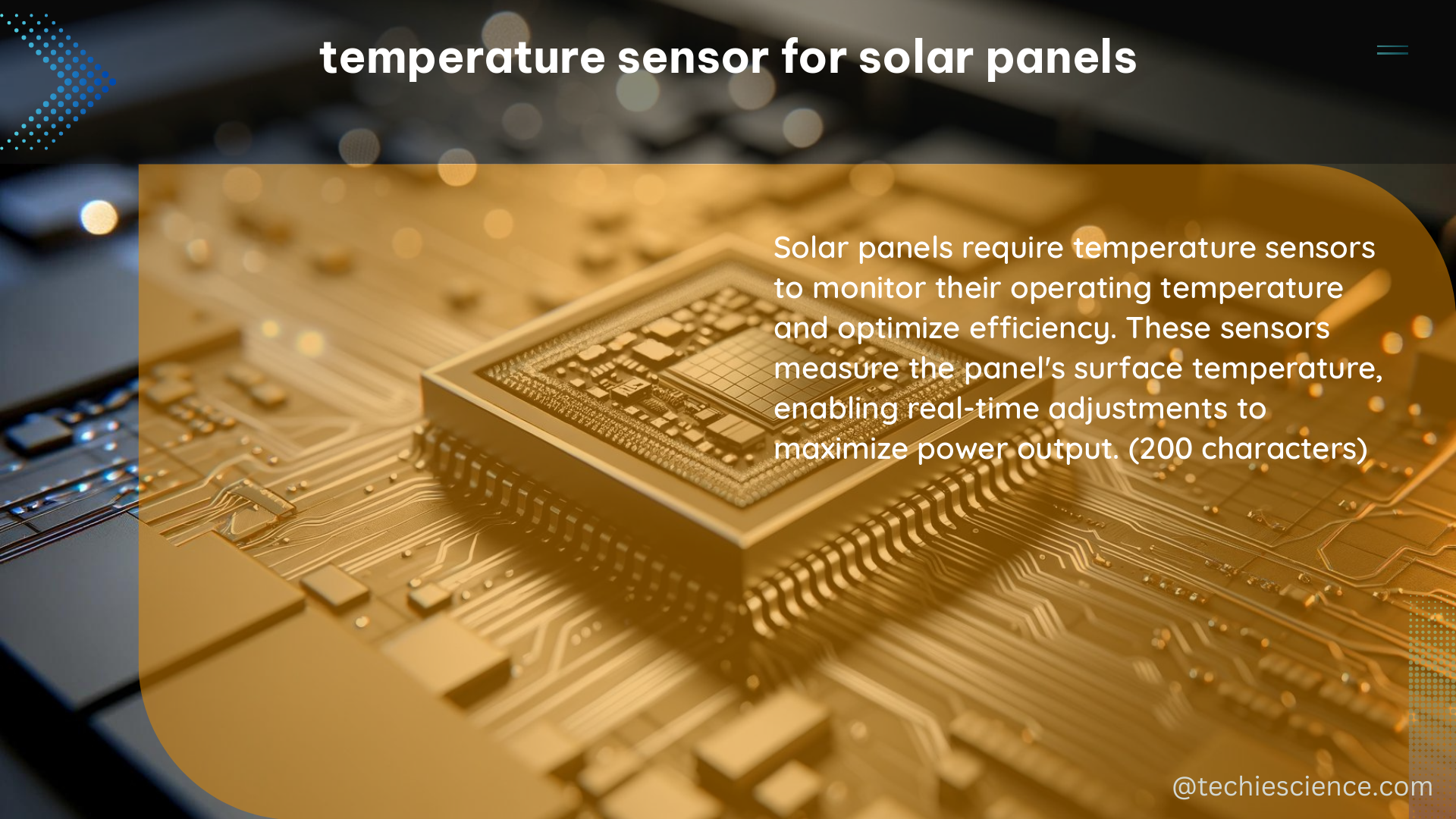Temperature sensors play a crucial role in the efficient operation of solar panels. By monitoring the temperature of the solar cells, the system can adjust the operating conditions to maximize energy production while minimizing degradation due to excessive heat. This comprehensive guide will provide you with in-depth, technical details on temperature sensors for solar panels, covering everything from sensor types to DIY implementation.
Temperature Sensor Types for Solar Panels
When it comes to temperature sensors for solar panels, there are two primary types: thermocouples and semiconductor-based sensors.
Thermocouples
Thermocouples, such as K-type and T-type, are widely used in solar panel applications due to their:
- Temperature Range: K-type thermocouples can measure temperatures from -200°C to 1260°C, while T-type thermocouples can operate from -200°C to 350°C.
- Accuracy: K-type thermocouples have an accuracy of ±2.2°C, and T-type thermocouples have an accuracy of ±1°C.
- Durability: Thermocouples are known for their ruggedness and ability to withstand harsh environmental conditions, making them suitable for outdoor solar panel installations.
- Cost-Effectiveness: Thermocouples are generally less expensive compared to semiconductor-based sensors.
Semiconductor-based Sensors
Semiconductor-based temperature sensors, such as Negative Temperature Coefficient (NTC) and Positive Temperature Coefficient (PTC) thermistors, offer the following advantages:
- Accuracy: NTC thermistors can achieve an accuracy of ±0.1°C, providing highly precise temperature measurements.
- Stability: Semiconductor-based sensors are known for their excellent long-term stability, maintaining their calibration over extended periods.
- Sensitivity: These sensors exhibit a high sensitivity to temperature changes, allowing for rapid response times, typically in the range of milliseconds to seconds.
However, semiconductor-based sensors have a more limited temperature range, typically from -55°C to 150°C, compared to the wider range of thermocouples.
Temperature Sensor Specifications for Solar Panels

When selecting a temperature sensor for your solar panel system, consider the following key specifications:
| Specification | Thermocouple | Semiconductor-based Sensor |
|---|---|---|
| Temperature Range | K-type: -200°C to 1260°C T-type: -200°C to 350°C |
-55°C to 150°C |
| Accuracy | K-type: ±2.2°C T-type: ±1°C |
±0.1°C |
| Response Time | Milliseconds to seconds | Milliseconds to seconds |
| Stability | Good | Excellent |
Additionally, factors such as sensor size, mounting options, and compatibility with your data acquisition system or microcontroller should be taken into account when choosing the appropriate temperature sensor for your solar panel application.
Integrating Temperature Sensors into Solar Panel Systems
To integrate a temperature sensor into a solar panel system, follow these steps:
-
Sensor Selection: Choose a temperature sensor that meets the specific requirements of your solar panel application, considering factors like temperature range, accuracy, response time, and stability.
-
Mounting: Securely mount the temperature sensor in close proximity to the solar cells to ensure accurate temperature measurement. This can be done using adhesives, clips, or brackets.
-
Wiring: Connect the temperature sensor to a data acquisition system or microcontroller for temperature monitoring and control. This typically involves wiring the sensor to an analog-to-digital converter (ADC) input on the data acquisition system or microcontroller.
-
Calibration: Calibrate the temperature sensor using a known reference temperature, such as an ice bath or a temperature-controlled oven. This step ensures accurate temperature measurement and compensates for any manufacturing variations in the sensor.
DIY Temperature Sensor Implementation for Solar Panels
If you’re interested in implementing a DIY temperature sensor for your solar panel system, follow these steps:
-
Materials: Gather the necessary materials, including a temperature sensor (e.g., K-type thermocouple, NTC thermistor), wiring, and a data acquisition system or microcontroller with an ADC input.
-
Assembly: Carefully assemble the temperature sensor and wiring, ensuring proper connection to the data acquisition system or microcontroller.
-
Calibration: Calibrate the temperature sensor using a known reference temperature to ensure accurate measurements.
-
Software: Develop software to read the temperature sensor data, display the temperature, and implement any necessary control algorithms to optimize solar panel performance based on temperature. This may involve integrating the sensor data with a microcontroller or a computer-based data acquisition system.
By following these steps, you can create a customized temperature monitoring system for your solar panel installation, allowing you to optimize energy production and minimize degradation due to excessive heat.
Conclusion
Temperature sensors play a crucial role in the efficient operation of solar panels. By understanding the different types of temperature sensors, their specifications, and the steps involved in integrating them into solar panel systems, you can ensure accurate temperature monitoring and optimize the performance of your solar panel installation. Whether you choose to use a commercial temperature sensor or implement a DIY solution, this comprehensive guide will provide you with the technical knowledge and practical steps to master temperature sensors for solar panels.
References
- Temperature Sensor Integration for Solar Panels
- Thermocouple Basics
- Solar Energy Technologies Office (SETO) Portfolio

The lambdageeks.com Core SME Team is a group of experienced subject matter experts from diverse scientific and technical fields including Physics, Chemistry, Technology,Electronics & Electrical Engineering, Automotive, Mechanical Engineering. Our team collaborates to create high-quality, well-researched articles on a wide range of science and technology topics for the lambdageeks.com website.
All Our Senior SME are having more than 7 Years of experience in the respective fields . They are either Working Industry Professionals or assocaited With different Universities. Refer Our Authors Page to get to know About our Core SMEs.